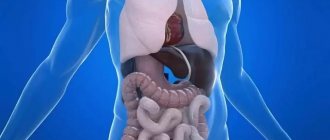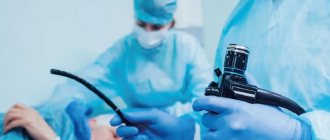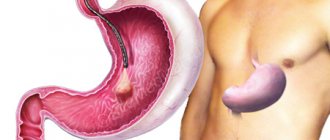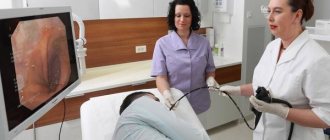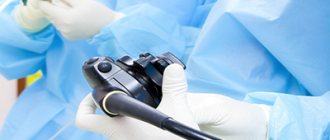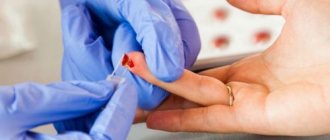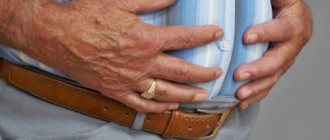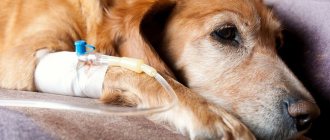In modern medicine, various methods of examining the gastrointestinal tract are used. The most common is the endoscopic direction. Gastroscopy allows the doctor to visually examine the esophagus, intestines and stomach in real time, as well as take tissue samples for laboratory tests. However, this method is not painless. Patients often complain that their throat hurts both after FGDS and during the procedure.
Carrying out FGDS
The FGDS procedure lasts no more than ten minutes. If a biopsy is needed, it will take a little longer.
The patient is placed on his left side, after which the oral cavity and larynx are treated with a local anesthetic to reduce sensitivity.
A mouthpiece is placed in the mouth, through which the endoscopist inserts a tube with a probe. The doctor moves it deeper with gentle movements, examining the inner walls of the duodenum and stomach. If an ulcer or tumor is found, he will take a tissue sample for a biopsy. He will also remove detected polyps if necessary.
FGDS is a safe procedure, but in some cases it causes pain. Most often this occurs with ulcers or cancerous tumors. In these cases, the patient is recommended to undergo diagnostics under anesthesia.
PRICES
- Diagnostics
Note! Prices are for adult patients. Please see the “Pediatrics” section for the cost of children’s appointments.
| FGDS (without Helicobacter pylori test) | 4 200 |
| Determination of gastric secretory function | 450 |
| Stomach biopsy using endoscopy (during FGDS, without the cost of laboratory research) | 600 |
| Helicobacter pylori, DNA [real-time PCR] | 850 |
FGDS of the stomach allows you to study in detail the condition of the mucous membrane and identify some diseases in the early stages, when they are still easily treatable. In addition, during the procedure, the doctor can collect material for subsequent research in the laboratory. Sometimes this is almost the only method of reliably diagnosing the disease, which is especially important for the treatment of malignant tumors.
Finally, another area of application of FGDS is its use as a therapeutic procedure. For example, this method successfully treats chemical burns of the esophagus and stomach walls, as well as internal bleeding from the esophageal veins. Other advantages include the effective identification of bleeding spots in the stomach, identification of the causes of nausea and heartburn, as well as, in general, any study of pathologies of the gastrointestinal tract.
What to do if your throat or stomach hurts after FGDS
Painful sensations in the stomach after gastroscopy in the absence of ulcers and tumors disappear on the second day. For severe pain, it is enough to take painkillers.
Sore throat occurs due to mechanical damage to the walls of the larynx by the endoscope. In this case, it is recommended to talk less and gargle with solutions of furatsilin and miramistin. Rinsing with saline solutions is also allowed.
Painful sensations will be alleviated by taking sea buckthorn oil (2-3 times a day, a teaspoon). Combined with the healing effects of honey, this will help speed up your recovery.
Sprays are also successfully used, effective for sore throats and easy to use. They have a complex effect - healing, anti-inflammatory and antimicrobial.
Our clinic employs experienced endoscopists who can conduct an FGDS examination painlessly and without complications.
Preparation for FGS
A good morale is the key to easy research
Despite the fact that this process is quite unpleasant, if you follow all the recommendations of the doctor who will carry it out, you can avoid bad feelings.
There are a number of recommendations that must be followed during preparation for the procedure:
- Dinner should be very light, and preferably 4 hours before bedtime
- 8 hours before the procedure, eating is strictly prohibited, since any meal immediately before FGS can provoke an attack of vomiting, due to which the study will be impossible and will have to be scheduled for another day.
- You should not smoke, especially before the procedure, as smoking exacerbates gag reflexes and also provokes the production of gastric mucus, which may cause the examination to take longer.
- You cannot take medications, and in particular tablets that must be swallowed.
Before FGS, the following actions are allowed, if this is very necessary:
Negative effects of anesthesia on the body
In addition, anesthesia (sedation) is not a completely safe method and can have rather dire consequences, which are called postoperative cognitive dysfunction, which has a negative effect on the brain. There are a lot of symptoms, they are usually associated with:
- disturbances of memory, sleep, hearing and even speech - you must agree, it is much more unpleasant than waiting out two or three minutes of nausea;
- decreased concentration - which is especially important for people who work with machinery or drive cars;
- deterioration in learning ability - unacceptable for the younger generation;
In some cases, symptoms go away within a few hours, and in some cases they last up to 12 months! Although in fairness, we note that the more time passes from the moment of administration of anesthesia, the weaker they appear.
The main risk groups here are elderly patients, people receiving repeated anesthesia for a short period of time or heading for long-term surgery, as well as those with infectious and respiratory diseases.
You should know that colonoscopy and gastroscopy must be carried out in different rooms, ensuring that the devices are used strictly for their intended purpose, so that the colonoscope does not accidentally end up in the esophagus and vice versa. This guarantees patients peace of mind and confidence since both devices are very similar, only the first one is longer; if the space is not demarcated, there is a possibility of confusing them.
What the patient should know
Another feature when conducting gastroscopy is that the doctor conducting the study must be in contact with the patient, which is why anesthesia is not acceptable here. And an additional danger to its implementation may be the presence of an allergy status to any component of anesthesia, which a person may not know about and be subjected to severe anaphylactic shock, the consequences of which can lead straight to the Sklifosovsky Institute. The formalities of sedation include the mandatory presence of a medical institution with a special drug license, the availability of which many patients simply do not consider necessary to check and are exposed to even greater risk.
There is an alternative to anesthesia - transnasal endoscopy!
The nasal endoscope is much thinner than a conventional gastroscope, its diameter is less than 4 mm, which allows the device to be inserted through the nose. Such an intervention is easily tolerated not only by adults, but also by small patients, reducing the likelihood of unpleasant sensations to a minimum.
The advantages of the study include not only the elimination of the gag reflex, but also low trauma, the ability to exclude local anesthetics, since the transnasal endoscope is also more flexible, with its help you can not only examine the required area, but also perform therapeutic manipulations.
What happens after the procedure?
Inserting an endoscope into the stomach causes discomfort that may persist in the throat for a couple of days, but nothing more. Patients may also experience slight abdominal pain, but this also goes away quickly. It is extremely rare that damage to the endoscope may result in bleeding in the wall of an internal organ, but in other cases there are practically no complications.
The consequences will be much more serious when patients neglect the doctor’s instructions and go for the procedure after eating. In this case, food debris can move higher into the respiratory tract, which, in turn, leads to an attack of suffocation. If a person strictly followed all the rules, neither he nor the doctor will have any problems during FGDS of the stomach. The specialist will receive clear and complete images of the internal walls, which will help him more accurately determine the diagnosis. In particular, FGDS allows you to determine:
- Volumetric formations in the gastrointestinal tract
- Patency of the esophagus, stomach and some parts of the intestine
- Hernia in the esophageal opening of the diaphragm
- Gastrointestinal diseases at different stages
- Changes in the condition of the mucous membrane
- Protrusion of the muscle wall and other pathologies and diseases
In the absence of food and water in the esophagus, all these problems are clearly visible on the monitor screen. Thanks to FGDS, the doctor can prescribe timely treatment and overcome the disease at an early stage.
Signs and symptoms that may indicate a complication
Signs and symptoms to watch for after a gastric endoscopy include: fever, chest pain, shortness of breath, bloody, black or very dark-colored stool, difficulty swallowing, severe or persistent abdominal pain, vomiting, especially if the vomit contains blood. or looks like coffee grounds.
Call your doctor or go to the emergency room right away if you experience any of these signs or symptoms.
print version
TagsHealth Endoscopy Gastric endoscopy
Infections
In most cases, gastric endoscopy consists of a visual examination of the organ lining and a biopsy, and the risk of infection is very low. The risk of infection increases when additional procedures are performed as part of a gastric endoscopy, such as the removal of several, up to 10 polyps. Most infections are minor and can be treated with antibiotics. The doctor, usually planning major interventions, prescribes prophylactic antibiotics before the procedure if the patient is at higher risk for this complication.
Duration
The research doesn't take too long. Thus, an average stay in the endoscopy room takes about an hour. But a direct internal inspection takes 7–12 minutes. The probing time increases depending on the manipulations performed using the endoscope. For example, biopsies, micro-surgeries, therapeutic actions. The total duration of the FGDS procedure may increase due to psychological factors, physiological characteristics and improper preparation.
The examination under sedation takes longer than usual. Here, additional time is spent on euthanasia and withdrawal from medicated sleep. But compared to anesthesia, the latter happens faster. Thus, the patient wakes up within 5–10 minutes after the end of the examination, and speaks and adequately perceives information within 15–20 minutes. Therefore, it is easy to calculate how much the duration of the procedure increases.
Other methods of examining the stomach
Although EGD of the stomach is a fairly simple and effective procedure, it is not always used. This is usually due to intolerance to the endoscope material or weakened walls of internal organs in which the endoscope can cause bleeding. It is extremely rare, but it still happens that patients are terrified of this procedure. If it is impossible to perform an FGDS of the stomach, the following alternative diagnostic methods are used:
- CT scan
- Magnetic resonance imaging
- X-ray examination. As you know, X-rays are used mainly to identify fractures, since bones are much denser than other tissues, and therefore are clearly visible in the image. To study the gastrointestinal tract, the patient takes barium sulfate, which is visible in X-rays and helps to determine pathological changes in the stomach.
- Capsule endoscopy. As with FGDS, the patient swallows a device with a camera, which transmits to the doctor images of the internal walls of the gastrointestinal tract (more precisely, records them on a medium). However, such a capsule is swallowed completely and travels through the intestines for a long time until it is eliminated from the body naturally. The advantage of this method is that it allows you to get a complete picture of the state of the gastrointestinal tract.
- Duodenal sounding. In this procedure, the patient slowly swallows a thin rubber tube. Through it, bile and other substances produced by the organs of the gastrointestinal tract come out.
All of these methods allow us to obtain a fairly reliable picture of the condition of the esophagus, stomach and intestines, however, none of them is as good as FGDS of the stomach. Usually doctors prescribe these diagnostic options as auxiliary methods, since they cannot be the only correct means of research. In addition, they only show a picture of the internal organs, while with the help of gastric gastroscopy, many important therapeutic procedures can be carried out when the diagnosis has already been determined.
Perforation (tear)
During gastric endoscopy, a rupture of the esophagus or other part of the upper digestive tract may occur. This complication may require hospitalization and sometimes surgery. The risk of this complication is very low - it occurs in approximately 1 in 2,500 to 11,000 diagnostic gastric endoscopies. The risk increases if additional procedures are performed during gastric endoscopy, such as dilatation of the esophagus (bougienage of scars or recanalization for tumors).
You can reduce the risk of complications by carefully following your doctor's instructions in preparation for an endoscopy, such as fasting and stopping certain medications (eg, aspirin, cardiomagnyl).
